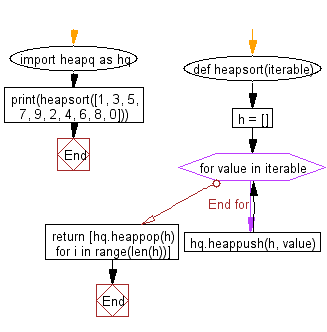Python: Pushing all values onto a heap and then popping off the smallest values one at a time
3. Heapsort Implementation
Write a Python program to implement heapsort by pushing all values onto a heap and then popping off the smallest values one at a time.
Sample Solution:
Python Code:
import heapq as hq
def heapsort(iterable):
h = []
for value in iterable:
hq.heappush(h, value)
return [hq.heappop(h) for i in range(len(h))]
print(heapsort([1, 3, 5, 7, 9, 2, 4, 6, 8, 0]))
Sample Output:
[0, 1, 2, 3, 4, 5, 6, 7, 8, 9]
Flowchart:

For more Practice: Solve these Related Problems:
- Write a Python program to implement heapsort by inserting all elements into a heap using heapq.heapify, then repeatedly calling heappop to produce a sorted list.
- Write a Python script to demonstrate heapsort on a large list of integers and compare its output with Python’s built-in sorted() function.
- Write a Python function that sorts a list using the heap queue algorithm and prints the intermediate heap states during sorting.
- Write a Python program to implement heapsort on a list of floating-point numbers and then validate that the final list is in ascending order.
Go to:
Previous: Write a Python program to find the three smallest integers from a given list of numbers using Heap queue algorithm.
Next: Write a Python function which accepts an arbitrary list and converts it to a heap using Heap queue algorithm.
Python Code Editor:
Have another way to solve this solution? Contribute your code (and comments) through Disqus.
What is the difficulty level of this exercise?
Test your Programming skills with w3resource's quiz.
